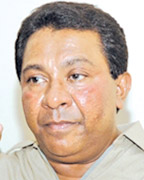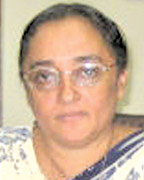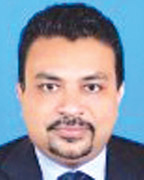|
After months-long fiasco over Z-score:
Warm welcome awaits biggest batch of students to Universities
By Ranil Wijayapala
For many youth who are aspiring higher positions in the society after
perusing free education in Sri Lanka, the General Certificate of
Education (Advanced Level) examination is a turning point in their life
as it decide the future of their life. But for the 294,800 students sat
for the GCE (A/L) examination in August 2011, had to test their patience
as they had to wait for a long time to decide on their future.
Though they were waiting to enter the university education with their
best performances at the examination, the dates were postponed day by
day as their Advanced Level examination results subjected to changes
repeatedly putting their future hopes in continuous jeopardy.
When exam results were subjected to changes whilst they were in
favour of some students it dimmed the hopes for another set of students,
dragging the entire process of university admission in to a dilemma.
Sometimes, high hopes of becoming doctors and engineers were
shattered for some, when their Z-score were subjected to changes.
Finally it ended in Court as everybody wanted justice to be carried out.
After a long agitations and campaigns and a long litigation process
they are now at the final lap of entering the university education as
the months long fiasco over the z-scores of the 2011 GCE (A/L)
examination came to an end last Saturday when the University Grants
Commission issued the cut off marks for different subject streams for
the admission of the highest ever intake to the Sri Lanka universities
for an academic year 2011/2012.
Therefore the students who sat for the GCE A/L examination in the
year 2011 will get their long awaited opportunity to start their
university education by the end of next month.
|

Minister S.B. Dissanayake |
Though the admission of students to the universities was scheduled
for October last year after providing leadership training program and
also the English and IT training for the qualified students, now they
are ready to commence their academic year five months behind the
schedule due to the z-scores fiasco.
Accordingly 26,944 students, which include 5,182 additional students
to universities, are expected to start their university education by the
end of March this year although the universities are not properly
equipped to cater that amount of students in a single academic year.
However, Higher Education Minister S.B. Dissanayake on Thursday
assured that his Ministry will take every possible steps to start the
2011/2012 academic year to facilitate education of these students.
"There may be congestion in the universities with the admission of
these additional number of students to the already congested
universities due to the increased number of students admitted to the
universities since 2005 and it may trigger picketing and protest by the
students, but the Government is doing its best to facilitate the
education of these students", the Minister said.
He said the Government has allocated Rs. 4 billion for this year to
improve the facilities at universities and the Cabinet has approved a
proposal to have seven new buildings for five universities at this
week's Cabinet meeting.
"We are already continuing discussions with a Singapore company to
construct prefabricated buildings and once the evaluation of the
proposal is completed universities will have the opportunity to
construct the required facilities faster", he said.
|

Prof. Kshanika
Hirimburegama |
According to Minister Dissanayake, different universities will adopt
different mechanism to facilitate the admission of additional number of
students to the universities by having lectures on different time
schedules, by renting out new buildings and other facilities.
Minister Dissanayake said that the Universities in the North and East
will face the most difficult situation due to the additional number of
students admitted to the universities due to the limited facilities
available in those universities.
"We discussed these matters in the past few months and the
universities are now ready to face the situation", he said.
Dr. Priyantha Premakumara, Additional Secretary to the University
Grants Commission explaining the mechanism adopted in deciding the
number of students to the universities under new and old syllabuses said
that they got the highest percentage of students under different subject
streams from the year 2005 to 2010 when calculating the number of
students to be admitted to the universities this year.
"We considered the highest percentage of students admitted to the
universities from 2005 to 2010 when calculating the student admission
under different subjects streams for the academic year 2011/2012 under
both syllabuses", he said. Therefore, we gave the highest percentage of
admissions under new syllabus and the old syllabus.
"When we are giving the highest percentage for each stream that will
automatically exceed the 100 percentage. That is why we proposed to the
Supreme Court that we will recruit 5,609 additional students to the
universities.
But that number was calculated on the basis that practical tests for
the arts stream students will not be conducted for this year. But
practical tests had to be conducted this year too as Court gave us
directions to conduct these practical tests this year too", he said.
Therefore, the UGC could not find the required number of students who
had passed the practical test to qualify for the university admission.
We could not get the required number of additional students for
university admissions from some districts in accordance with the
undertaking the UGC gave the Courts, he said.
However, he said the UGC got the permission from the Courts through a
motion to get the highest possible number under both the new and old
syllabuses.
|

Dr. Priyantha
Premakumara |
Accordingly, Dr. Premakumara said, 13,470 students under the new
syllabus and 13,474 students under the old syllabus will get university
admission for this academic year. "The total number of university
admissions were shared equally under the new syllabus and the old
syllabus", he said. According to the UGC statistics, 22,016 students for
the academic year 2010/2011, 21,547 students for the academic year
2009/2010, 20,846 students for the academic year 2008/2009 and 20,069
students for the academic year 2007/2008 have been admitted to
universities in the country.
For the academic year 2011/2012 the UGC will admit 1,315 students for
Medicine (470 under new syllabus and 845 under old syllabus) 115 for
Dental Surgery (44 under new syllabus and 71 under old syllabus) 146 for
the Veterinary Science (55 under new syllabus and 91 under old
syllabus), 84 for Engineering (EM) (39 under new syllabus and 45 under
old syllabus) 87 for Engineering (38 under new syllabus and 49 under old
syllabus) 4,000 for Management (2,713 under new syllabus and 1,287 under
old syllabus) 445 for Law Faculty ( 319 under new syllabus and 126 under
old syllabus) and 5,945 for Arts (3,491 under new syllabus and 2,454
under old syllabus) will be admitted to the universities.
Dr. Premakumra said that the number will further increase when
students under special category and additional category are considered
for university admissions. Chairperson of the University Grants
Commission Prof. Kshanika Hirimburegama said that the UGC is now in the
process of sending letters to the students to finalise the admission of
students to the universities.
"We understand that many students are still having problems with
regard to the university admission as some who were qualified for
university entrance under earlier z-score are not qualified for the
university entrance under the new z-score. If the students are having
any problem we request the students to send their written submissions to
us so that we can solve their problems. We are ready to discuss their
problems as we consider this a special situation", Prof. Hirimburegama
said.
Vice Chancellor of the Moratuwa University Prof. Ananda Jayawardhena
and Vice Chancellor of the Uva-Wellassa University Prof. Ranjith
Premalal said they are making some adjustments in their universities to
accommodate more students for the academic year 2011/2012. |



